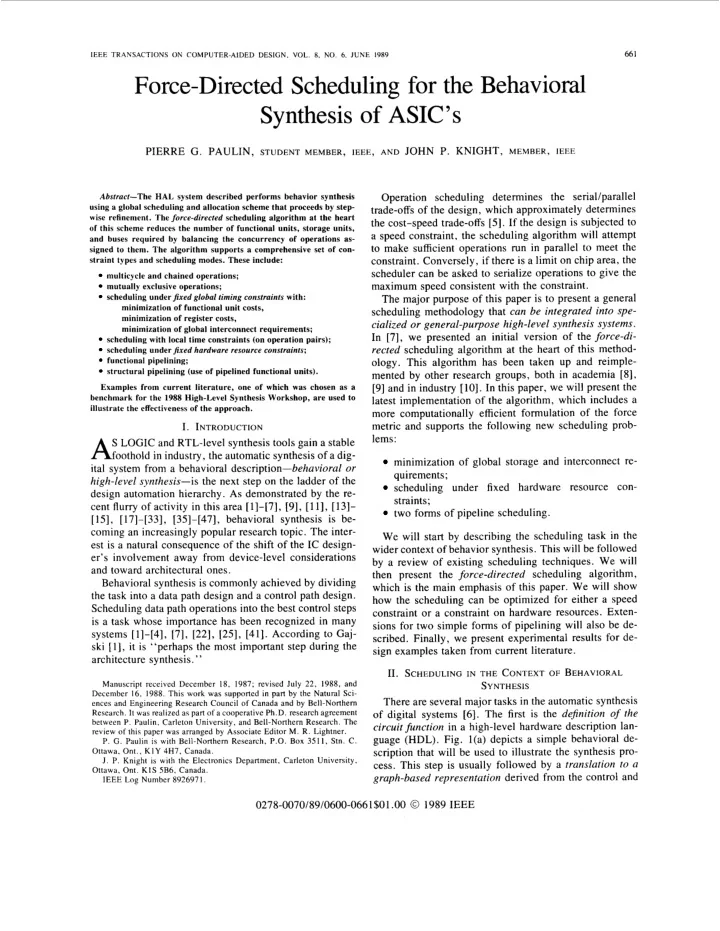

1 zyxwvutsrqponmlkjihgfedcbaZYXWVUTSRQPONMLKJIHGFEDCBA IEEE TRANSACTIONS ON COMPUTER-AIDED DESIGN, VOL. zyxwvutsrqponmlkjihgfedcbaZYXWVUTSRQPONMLKJIHGFEDCBA 8, NO. zyxwvutsrqponmlkjihgfedcbaZYXWVUTSRQPONMLKJIHGFEDCBA 66 6, JUNE 1989 Force-Directed Scheduling for the Behavioral Synthesis of ASIC’s and buses required by balancing the concurrency of operations zyxwvutsrqponmlkjihgfedcbaZYXWVUTSRQPONMLKJIHGFEDCBA Operation scheduling determines the serial/parallel Abstract-The HAL system described performs behavior synthesis trade-offs of the design, which approximately determines using a global scheduling and allocation scheme that proceeds by step- scheduling under zyxwvutsrqponmlkjihgfedcbaZYXWVUTSRQPONMLKJIHGFEDCBA wise refinement. The force-directed scheduling algorithm at the heart the cost-speed trade-offs [5]. If the design is subjected to of this scheme reduces the number of functional units, storage units, a speed constraint, the scheduling algorithm will attempt as- to make sufficient operations run in parallel to meet the signed to them. The algorithm supports a comprehensive set of con- constraint. Conversely, if there is a limit on chip area, the straint types and scheduling modes. These include: scheduler can be asked to serialize operations to give the multicycle and chained operations; maximum speed consistent with the constraint. mutually exclusive operations; j x e d global timing constraints with: The major purpose of this paper is to present a general minimization of functional unit costs, scheduling methodology that can be integrated into spe- minimization of register costs, cialized or general-purpose high-level synthesis systems. minimization of global interconnect requirements: In [7], we presented an initial version of the force-di- scheduling with local time constraints (on operation pairs): rected scheduling algorithm at the heart of this method- scheduling under fixed hardware resource constraints; ology. This algorithm has been taken up and reimple- functional pipelining; ita1 system from a behavioral description-behavioral zyxwvutsrqponmlkjihgfedcbaZYXWVUTSRQPONMLKJIHGFEDCBA structural pipelining (use of pipelined functional units). mented by other research groups, both in academia [8], [9] and in industry [lo]. In this paper, we will present the Examples from current literature, one of which was chosen as a latest implementation of the algorithm, which includes a benchmark for the 1988 High-Level Synthesis Workshop, are used to illustrate the effectiveness of the approach. more computationally efficient formulation of the force I. INTRODUCTION metric and supports the following new scheduling prob- lems: S LOGIC and RTL-level synthesis tools gain a stable A foothold in industry, the automatic synthesis of a dig- minimization of global storage and interconnect re- or quirements; the next step on the ladder of the high-level synthesis-is scheduling under fixed hardware resource con- design automation hierarchy. As demonstrated by the re- straints; cent flurry of activity in this area [11-[71, [91, [lll, [131- two forms of pipeline scheduling. [15], [17]-[33], [35]-1471, behavioral synthesis is be- coming an increasingly popular research topic. The inter- We will start by describing the scheduling task in the est is a natural consequence of the shift of the IC design- wider context of behavior synthesis. This will be followed er’s involvement away from device-level considerations by a review of existing scheduling techniques. We will and toward architectural ones then present the force-directed scheduling algorithm, Behavioral synthesis is commonly achieved by dividing which is the main emphasis of this paper. We will show the task into a data path design and a control path design. how the scheduling can be optimized for either a speed Scheduling data path operations into the best control steps constraint or a constraint on hardware resources. Exten- is a task whose importance has been recognized in many sions for two simple forms of pipelining will also be de- systems [1]-[4], [7], [22], 1251, [41]. According to Gaj- scribed. Finally, we present experimental results for de- ski [l], it is “perhaps the most important step during the sign examples taken from current literature. architecture synthesis.” 11. SCHEDULING IN THE CONTEXT OF BEHAVIORAL Manuscript received December 18, 1987; revised July 22, 1988, and SYNTHESIS December 16. 1988. This work was supported in part by the Natural Sci- There are several major tasks in the automatic synthesis ences and Engineering Research Council of Canada and by Bell-Northern .OO zyxwvutsrqponmlkjihgfedcbaZYXWVUTSRQPONMLKJIHGFEDCBA Research. It was realized as part of a cooperative Ph.D. research agreement of digital systems [6]. The first is the definition of the between P. Paulin. Carleton University, and Bell-Northern Research. The circuit function in a high-level hardware description lan- review of this paper was arranged by Associate Editor M. R . Lightner. guage (HDL). Fig. l(a) depicts a simple behavioral de- P. G. Paulin is with Bell-Northern Research, P.O. Box 3511, Stn. C. Ottawa, Ont., KIY 4H7, Canada. scription that will be used to illustrate the synthesis pro- J . P. Knight is with the Electronics Department, Carleton University, cess. This step is usually followed by a translation to a Ottawa, Ont. KIS 5B6, Canada. graph-based representation derived from the control and IEEE Log Number 892697 1. 0278-0070/89/0600-0661$01 0 1989 IEEE
Recommend
More recommend